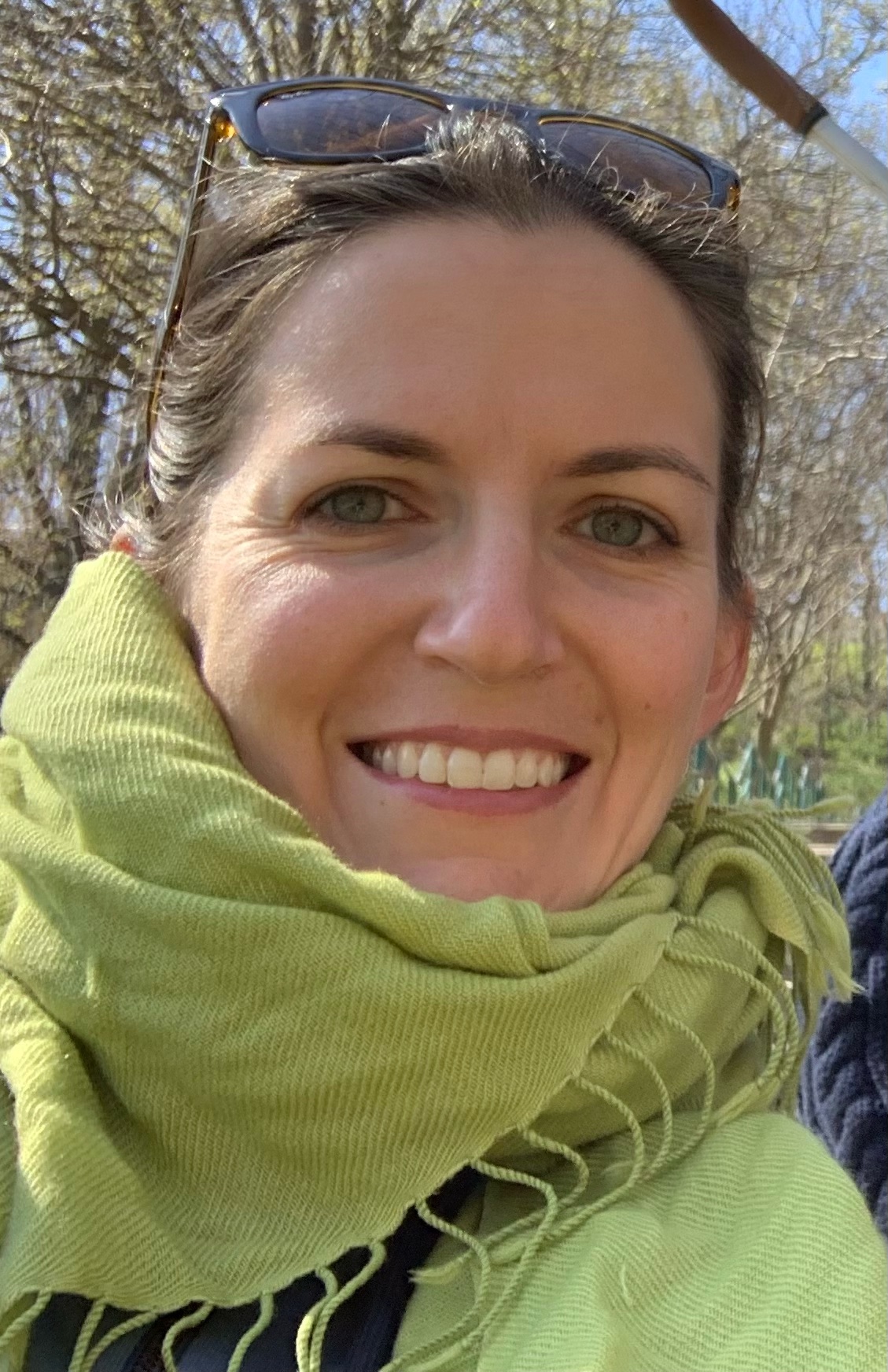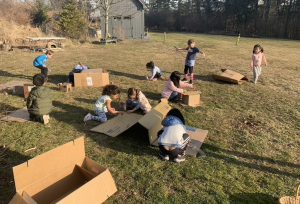 We live in a rapidly changing world, both societally and physically, as our environment evolves in the face of climate change. As an educator, I believe that our children need opportunities to develop creative, divergent thinking that will empower them to develop new solutions to new problems. I believe that play in nature inspires an affinity and appreciation for the natural world, leading to stewardship and care for the planet.
We live in a rapidly changing world, both societally and physically, as our environment evolves in the face of climate change. As an educator, I believe that our children need opportunities to develop creative, divergent thinking that will empower them to develop new solutions to new problems. I believe that play in nature inspires an affinity and appreciation for the natural world, leading to stewardship and care for the planet.
In my work as a Tinkergarten Teacher, I provide children with joyful, nature-based play opportunities that allow them to activate behavioral schema that encourages physical and cognitive development. Purposeful outdoor open-ended play is both soothing and stimulating for children, allowing them to reap the wellness benefits of time in the outdoors while they learn and grow through play.
Many studies have shown that time spent in nature provides us with numerous wellness benefits: reduced stress, increased vitamin D, improved circulation, and even healthier sleep patterns! Simply spending a bit more time outdoors provides everyone with these benefits – as little as 2 hours total per week. For children in particular, the inherent variations afforded by a natural outdoor space – slightly uneven ground, hills, different textures underfoot – encourage essential physical development in a gentle and authentic way that can’t be found indoors or in a more manmade, artificial environment.
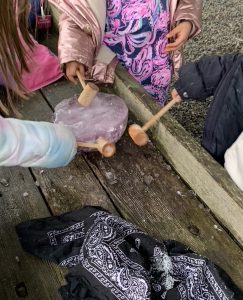 Outdoor time tends to lead to greater physical activity, which brings a host of mental and physical health benefits. Two very important body systems, proprioception and the vestibular system, can particularly benefit from increased outdoor play. Proprioception is our “sixth sense,” or an understanding of where our bodies are in space. It lets us know how much pressure to use to, say, open a door, and how to coordinate all the muscles needed for many daily tasks. Activating your proprioception can be very calming and centering, like using a weighted blanket. Young children activate proprioceptive feedback through jumping, stomping, crawling, climbing, pushing, pulling, or stretching – and the outdoors allows for lots of this activity in open and interesting spaces.
Outdoor time tends to lead to greater physical activity, which brings a host of mental and physical health benefits. Two very important body systems, proprioception and the vestibular system, can particularly benefit from increased outdoor play. Proprioception is our “sixth sense,” or an understanding of where our bodies are in space. It lets us know how much pressure to use to, say, open a door, and how to coordinate all the muscles needed for many daily tasks. Activating your proprioception can be very calming and centering, like using a weighted blanket. Young children activate proprioceptive feedback through jumping, stomping, crawling, climbing, pushing, pulling, or stretching – and the outdoors allows for lots of this activity in open and interesting spaces.
A complimentary movement system in our bodies is our vestibular system – centered in the inner ear, this system helps us coordinate our balance and muscle tone, and, when engaged, can even promote attention and focus! Rolling down a hill, spinning, swinging, or even running and changing directions are all great ways to engage the vestibular system, and promoting these types of movements is easy to do when you’re playing outdoors. A study from the Kaiser Family Foundation found that children ages 8 and up spend about 8 hours a day engaging with screens, and most of this time is physically inactive. With schools and screens encouraging a lot of sitting, we all could benefit from a good dose of joyful outdoor movement!
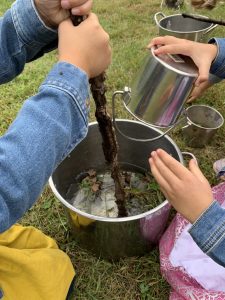 While all outdoor time is beneficial to our bodies and minds, open-ended play opportunities are an important balance to the structured school days and sports and other classes in which our children most frequently engage. Open-ended play encourages creativity and self-determination, as children develop their imaginations and build a sense of self, both physically and mentally. Researchers have studied the impact of pretend play for children ages 2-7: stronger language and communication skills, self-regulation, abstract thinking, and creativity. Our natural environment provides a nurturing and endlessly fascinating environment for developing imaginative, pretend play – what might begin as picking up a stick and testing out the different sounds it makes against different surfaces, can lead to that stick becoming a tail, a magic wand, a bridge, a horse… limitless engaging opportunities to develop imagination, take multiple perspectives, explore rudimentary physics, and have a lot of fun! There’s a reason Wired magazine declared the stick to be the #1 toy of all time – in fact there are infinite reasons!
While all outdoor time is beneficial to our bodies and minds, open-ended play opportunities are an important balance to the structured school days and sports and other classes in which our children most frequently engage. Open-ended play encourages creativity and self-determination, as children develop their imaginations and build a sense of self, both physically and mentally. Researchers have studied the impact of pretend play for children ages 2-7: stronger language and communication skills, self-regulation, abstract thinking, and creativity. Our natural environment provides a nurturing and endlessly fascinating environment for developing imaginative, pretend play – what might begin as picking up a stick and testing out the different sounds it makes against different surfaces, can lead to that stick becoming a tail, a magic wand, a bridge, a horse… limitless engaging opportunities to develop imagination, take multiple perspectives, explore rudimentary physics, and have a lot of fun! There’s a reason Wired magazine declared the stick to be the #1 toy of all time – in fact there are infinite reasons!
Open-ended free play helps children develop divergent thinking, an aspect of creativity that promotes problem-solving. Divergent thinking can be seen when we brainstorm – coming up with as many potential possibilities for something, without worrying about conventional boundaries or restraints just yet. In an ever-evolving world, when each year brings new technology and changes, this is an essential life skill, and one that can be cultivated through play. In school and similar learning environments, children get many experiences with convergent thinking, when we focus on identifying one efficient and clear solution. They get a lot of chances to exercise their convergent “muscles,” which is why supporting free play opportunities can provide such added benefit.
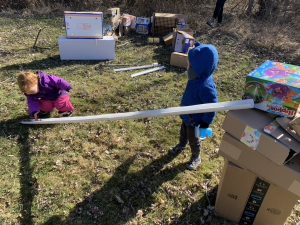 Sometimes children can benefit from a suggestion, or “invitation” for their play. Play looks different at different ages, and many different types of play are valuable in their own right; there’s not a “best way” to play. Sometimes children can seem to struggle to enter into free play, perhaps a side effect of the highly scheduled lives we all tend to lead. Without opportunity and “practice,” imaginative play can become an underdeveloped skill. In comes “guided play,” in which an adult identifies an opportunity for playful learning, perhaps by introducing an intriguing material or prop, like the aforementioned stick, or a piece of string, a box, a pile of acorns. What makes all of these items great play opportunities is their open-endedness: they don’t tell children how they should be used or what they mean, they provide a blank-but-interesting slate for children to project their own creativity. Guided play can act as a runway for free play, as well as a great opportunity for adults and children to co-play. It’s a good opportunity for adults to practice stepping back and following the lead of children, while modeling curiosity, excitement, and enjoyment.
Sometimes children can benefit from a suggestion, or “invitation” for their play. Play looks different at different ages, and many different types of play are valuable in their own right; there’s not a “best way” to play. Sometimes children can seem to struggle to enter into free play, perhaps a side effect of the highly scheduled lives we all tend to lead. Without opportunity and “practice,” imaginative play can become an underdeveloped skill. In comes “guided play,” in which an adult identifies an opportunity for playful learning, perhaps by introducing an intriguing material or prop, like the aforementioned stick, or a piece of string, a box, a pile of acorns. What makes all of these items great play opportunities is their open-endedness: they don’t tell children how they should be used or what they mean, they provide a blank-but-interesting slate for children to project their own creativity. Guided play can act as a runway for free play, as well as a great opportunity for adults and children to co-play. It’s a good opportunity for adults to practice stepping back and following the lead of children, while modeling curiosity, excitement, and enjoyment.
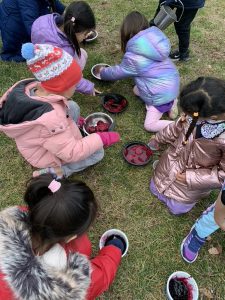 If you’re inspired to start playing, and unsure where to start, a great divergent play opening move is to choose an object: household (colander, bowl, box, string) or natural (stick, rock, leaf, pinecone), really anything will do. Take turns changing the meaning of the item by finishing this sentence: “It’s not a (box, pinecone, etc.), it’s a……..!” When in doubt, listen to your child. Allow for long pauses – in these interludes, their brains are revving up their creativity!
If you’re inspired to start playing, and unsure where to start, a great divergent play opening move is to choose an object: household (colander, bowl, box, string) or natural (stick, rock, leaf, pinecone), really anything will do. Take turns changing the meaning of the item by finishing this sentence: “It’s not a (box, pinecone, etc.), it’s a……..!” When in doubt, listen to your child. Allow for long pauses – in these interludes, their brains are revving up their creativity!
Encouraging more child-led play leads to greater development of creative thinking, problem solving, and self-efficacy in children. These qualities are what our future citizens and leaders will need, to navigate a constantly evolving world. Free play in the outdoors not only benefits children’s health in the present day, but leads to lifelong stewardship and enjoyment of our natural environment.
For more great play opportunities, check out local Tinkergarten events with Nature Play, NJ! We have weekly classes on Sunday mornings in Princeton, and monthly afternoon classes on the first Sunday of the month at Herrontown Woods. More information can be found at the Nature Play, NJ website. If you’re interested in DIY activities to spark joyful play at home, the Tinkergarten DIY collection is searchable by age and skill, and all activities use minimal materials found at home or in the natural world.
